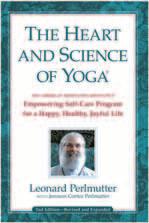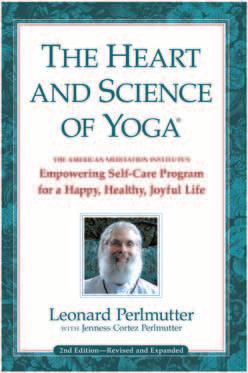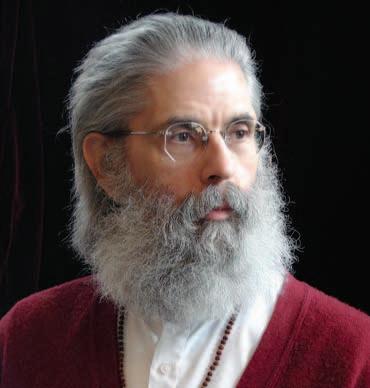“We









“We








By Leonard Perlmutter (Ram Lev)
For most Americans today, celebrating the Fourth of July means a holiday from work, enjoying a family reunion or picnic, and watching a spectacular fireworks display orchestrated to the uplifting strains of John Philip Sousa’s “Stars and Stripes Forever.”
And although it’s not one of today’s most popular forms of celebration, the Fourth of July holiday offers spiritual seekers the rare, but rewarding opportunity to learn how Yoga Science and Philosophy directly influenced the writing of the Declaration of Independence. For example, did you know that both Presidents Thomas Jefferson (1743-1826) and John Adams (1735-1826) owned and cherished rare copies of both the Bhagavad Gita and the Upanishads? Both of these sacred yogic texts appear to have influenced these founding fathers’ points of view, and substantially contributed to the philosophical foundation on which the American nation has been built.
Historians readily acknowledge that Jefferson was significantly influenced by renowned English philosopher John Locke.
Specifically, Thomas Jefferson was attracted to Locke’s yogic insights into the nature of Happiness presented in his historically acclaimed book, “An Essay Concerning Human Understanding,” published in 1681. It was from this 17th century work that Jefferson appropriated Locke’s phrase “pursuit of happiness,” and incorporated it into his most quoted, but perhaps least understood pronouncement of humanity’s unalienable right to “Life, Liberty, and the Pursuit of Happiness” in the Declaration of Independence. Additionally, the lessons of the ancient Katha Upanishad are reflected in Locke’s, and consequently, Jefferson’s profound understanding that, “The necessity of pursuing Happiness is the foundation of Liberty” as long as that Happiness represents a careful, welldisciplined and “constant pursuit of true and solid happiness; not mistaking imaginary happiness for Real Happiness.”
Does all this mean that Thomas Jefferson was a Yoga Scientist, a student of Yoga Science and Philosophy? Probably not. But based on his interests, intuitions and
writings, it is safe to say that Thomas Jefferson was an intutive human being earnestly searching for understanding, and for ways to become an instrument of Higher Knowledge.
Serving as a representative from the Commonwealth of Virginia, Jefferson spent the spring and summer of 1776 in Philadelphia, attending regular sessions of the Second Continental Congress and completing his draft of the Declaration of Independence. It was during this time that all the various philosophical influences that had inspired Jefferson were crafted into a focused, practical, sage decree for the ages: “We hold these truths to be self-evident, that all [people] are created equal, that they are endowed by their creator with certain unalienable rights, that among these are Life, Liberty and the pursuit of Happiness.”
Life, Liberty and Happiness are words quite familiar to every American today, but when you learned the Preamble to the Declaration of Independence in grade school, did you ever stop to consider what an “unalienable” right meant? Was this mere poetry? No, not from the perspective of Yoga Science. An “unalienable” right can never be separated from any of us because, on the highest level of consciousness, Life, Liberty and Happiness is us. The desire for Life is an expression of our eternal nature, Sat in Sanskrit. The desire for Liberty (the freedom to access knowledge and the freedom that comes from using that knowledge) is an expression of our intuitive consciousness and wisdom, Chit. And Happiness is the expression of our inherent fullness or bliss forever residing at the core of our being, known as Ananda.
In 1776, by defining Life, Liberty and Happiness as unalienable rights, Jefferson was acting as an instrument of Divine Grace, inspiration and awakening for all who would follow. Today, in 2024, Jefferson would
explain that “Unalienable rights” are rights that cannot be separated from us because Life, Liberty and Happiness, collectively, is us having separate human experiences. Over the centuries, Jefferson’s revolutionary, philosophical-political pronouncement found in the preamble to the Declaration of Independence, has timelessly reflected the yogic understanding that despite the appearance of seemingly separate human bodies and minds, there truly is only One Consciousness that has manifested the appearance of many forms. This bliss-filled, eternal awarenss and wisdom that now appear to be you in the form of the reader, is the very same Oneness that appears to be me, in the form of the writer of this essay. Ostensibly two, but essentially One.
Therefore, according to Yoga Science, the profound meaning of Jefferson’s “pursuit of Happiness” phrase clearly did not indicate that each of us should chase after every attractive object, exhausting our creative energy through the senses, just to experience a momentary pleasure that may leave only pain in its wake. Rather, Jefferson, like Locke before him, was suggesting that when we, as a nation, experiment with making conscious, discriminating choices that serve the Divine Super Conscious Wisdom available to us through the Conscience, each of us will embody lasting Happiness.
And that Happiness will, as Jefferson could see, become the foundation upon which real Liberty and freedom can continually give birth to a more perfect Union, give birth to the establishment of Justice, give birth to the assurance of domestic Tranquility, give birth to the adequate provision for the common defense, give birth to the ongoing promotion of the general Welfare, and give birth to the guaranteed security of the Blessings of Liberty to ourselves and to Posterity




Knowledge alone liberates. As a blazing fire reduces a pile of wood to ashes, so the fire of wisdom reduces all actions to ashes, says the Bhagavad Gita. Wisdom or knowledge does not nullify actions, only their binding power. Wisdom and knowledge purify the way of life and action. A rope can bind no more when it is burned, though it may still appear as a rope of bondage. Similarly actions bind human beings, but if they have been tempered by the fire of wisdom, although they may retain the appearance of action, they no longer have the power to bind. The energy that finds expression in the action has been transformed into knowledge and wisdom.
How are we to create in us that fire of knowledge in which to burn the faulty habits that motivate our actions? We cannot escape our actions by trying to run away from them. Closing our eyes or running away from an action does not make it vanish. It will still be there when we open our eyes again. Life's problems are not to be avoided. They have to be faced and accepted. Coming to grips with life and karma by meeting their challenges with knowledge, spiritual strength and skillful action, done selflessly, is the only way to be free. Very often people believe in doing good deeds and adopt it as a philosophy of life. This cannot go very far if it is only an
outward expression. Belief only in what one considers to be good is a superficial philosophy. It proves inadequate when confronted by the complex trials of life. The greatest strength comes only from a deep selflessness in life, expressed through mind, action and speech. One must not forget that the source of this strength is Atman, the very soul of oneself. After careful self-examination, having pondered the meaning and significance of life, one must try to live performing actions selflessly to the last breath of one's life. Inaction leads to inertia, and selfish actions can become a bondage which tightens the rope of karma.
Selfishness is the negation of spiritual awareness. Animals are meant to be selfish for they have no experience of their true selves. It is only in human beings that subjective awareness is found. Control and discipline and knowing the art of doing one’s actions in harmony with one’s psycho-physical personality are means for deepening selfawareness and realization of one’s true Higher Self, the eternal self-illumined, everfree Self.
What we call fate is also one’s own making. That which was done by one in the past becomes one’s fate. By knowing the art of living and by acting selflessly we can go
beyond time, space and causation. The human mind defines objects and events of the world of experience in terms of space and time. But, what exactly is space and time? They have no absolute reality in themselves. They are only relative concepts. When mind is made one-pointed it moves to a higher dimension of awareness, beyond time, space and causation, and there freedom becomes possible.
Grief and delusion come as a result of self-identification with limited physical and mental states. Identifying with the body, senses and mind, which are only minor dimensions of our being, we remain weak, helpless and limited, cut off from others. In such a state of weakness we make mistakes that reinforce the bondage of karma.
Lacking awareness of the Truth within us, we separate ourselves from the whole and create a small personality, a personal mask for ourselves. Selfless actions done to the best of one's ability lead to a state of tranquility, and only a tranquil mind can experience all levels of consciousness and finally attain liberation.
Deep faulty habit patterns can be seen as the consequences of the ignorance that cuts us off from the mainstream of life. A river cut off from its mainstream becomes stagnant; a person cut off from the mainstream of life falls into grief and delusion.
The capacity of awareness grows in the human mind by the disciplined practicing of social awareness as a citizen and by following inner discipline as a spiritual seeker. Total discipline helps one to achieve freedom from all gross and subtle bondage. When one learns how to perform selfless actions, one simultaneously expands the mind. This leads to an awakening to the basic unity of existence and consequently to liberation. Thus, by doing one’s duty selflessly one is practicing spirituality in daily life.
There will always be differences of opinion regarding what is the best action, but such differences will only be on the surface. Deep down there is only one unity. Whatever work or action one does, whatever their position in life, they contain within themselves an integral value, spiritual value proceeding
from the soul. When one learns to spiritualize all actions, thoughts and desires, that person will be able to perform actions and duties without bondage.
Thus when we want to avoid the sufferings and sorrows arising from faulty habits, we should discipline our senses, organs of action and mind at all levels, while taking care not to ignore our duties. We pay karmic debts only by performing selfless actions. Without paying our karmic debts to the people with whom we live, such as our birth-family, we will have no way of attaining freedom. Working to perform our duties conscientiously and sincerely among the people with whom we live helps us by not creating further bondages and obstacles in the path of enlightenment. The fire of knowledge burns on the fuel of selfless action, and thus karmic debts are met. To gain freedom from past actions and karmas one can learn to act so that karma becomes a useful tool rather than an obstacle on the path to enlightenment.
The knower, the known and the process of knowing comprise the three-fold nature of the drive to action. Each of these three divisions is in accordance with the three qualities of sattva, rajas and tamas. The universe contains many beings. Each being is unique. Variety is the nature of the universe. Yet, in this diversity one feels the presence of oneness; this is due to sattva-empowered knowledge. The undivided reality in diversity is known because of sattva. For example, the ocean has many waves and they are distinct from one another, yet they are all made from the same water. And gold is made into various ornaments, but the gold is common to them all. To see this oneness in different forms is sattva -empowered knowledge. There exist in the world many religions. Yet in spite of their multiplicity, one can see in them all a oneness of being, and can accordingly relate in one way toward all of them. This capacity results from sattva -empowered knowledge. Human beings, birds, beasts and insects are all different, yet they possess the one life principle in common. To regard them all as alike is due to sattva-empowered knowledge.
Rajas-empowered knowledge enables
one to identify divisions and variety of forms. The variety of aspects in each object is seen by rajas-empowered knowledge. The disposition that dwells on diversity alone is due to rajas. It frustrates all efforts towards seeing unity in diversity.
Tamas-empowered knowledge actually obscures the relationship of cause and effect and cannot reveal Truth. It is the cause of ignorance, which confuses cause and effect. It is false knowledge, sheer ignorance and impure ideas, and is contrary to enlightenment. Tamas-empowered people mistake a part for the whole and attach themselves to that part. They even lead themselves to destroy the whole. Tamas-empowered knowledge creates attachment and destruction.
Thus sattva -empowered knowledge sees unity in diversity while tamas-empowered knowledge sees diversity even in unity. Sattva-empowered knowledge inspires one to perform actions with the goal of selfrealization while tamas-empowered knowledge leads to self-degradation. That action is called sattvic-empowered which is done without attachment, without lust or hatred and without a selfish desire to enjoy the fruit of one’s actions. Lust and hatred make the mind extremely agitated. They must be renounced if one is to pursue the tranquil mind.
An action that is done with a tranquil mind is a sattvic action; but an action that is done with the desire to selfishly enjoy the fruit, with a view always to keep it for one's own enjoyment, ignoring its cost in labor and effort and with overwhelming confidence in one's ability, that action is rajasic Sattvic actions are performed without egoism, without thought of enjoying the fruits, without attachment, lust or hatred. Rajasic actions are permeated with all of these negative qualities. Actions performed without the desire to enjoy their fruits will lead to greater happiness. Rajasic actions can lead only to greater misery. Tamasic action leads only to degradation. It happens without thought of what damage or injury it might cause. Therefore one should observe oneself carefully to guard against taking tamasic actions.
The types of actions people take are determined by their dispositions. One whose steadiness of mind remains undisturbed in
doing actions and duties is indeed a balanced person. One who is not elated with success or disappointed with failure is sattvic. Such individuals possess courage and no anxieties about success or failures. They are neither puffed up with success nor downhearted with failure.
The characteristic of rajasic people is that they tend to become addicted to enjoyment. They have a keen desire for pleasure. At the root of all their activities lies the drive for enjoyment. They naturally seek enjoyment from the fruits of their own action. Those attached to pleasure are bound to be greedy. Having gotten some pleasure, they yearn for more pleasures; having lost them, their grief is beyond description. Joy and grief swing their minds one way or the other. Thus they are perpetually agitated. Such restless people find it difficult to really enjoy any pleasure. On the spur of the moment they can become violent; especially if they confront any obstacle in the way of their enjoyment, they may even react and try to destroy it. This increases the hatred and violence in a rajasic person. Where enjoyment, greed and violence reign, it is impossible to maintain the body, speech and mind in serenity.
The characteristics of tamasic people are ignorance and delusion, for they have no competence to do anything skillfully. A tamasic person is devoid of good conduct because of their very ignorance; only a person of good conduct can become a good human being. Tamasic people, filled with delusions, can’t contribute to knowledgeable discussions, nor perform any activity with skill, nor propagate good ideas. They remain lazy and dull in all circumstances. In the absence of inspiration there is no possibility of self-advancement through action, work or duty. When unable to grow through one’s own actions, duties and efforts, the mind begins to run in crooked avenues of tamas, and one grieves over failure. Such a person begins to hate others; and never rejoices at other people’s success. They are always sad, gloomy and hateful.
All things that appear on the face of the earth and in the universe have the three qualities of sattva, rajas and tamas. The whole universe is a play of these three qualities.
These qualities are found in our subtle habit patterns and determine the life course, here and hereafter. If people observe themselves impartially, they can discover whether their disposition is sattvic, rajasic or tamasic, and thus determine the future course to take.
Karma is inevitable, and one’s work is worship. By worshipping that Supreme Intelligence from whom all beings have manifested and by whom all this universe is pervaded, a person attains enlightenment.
The soul is the Inner Dweller of this body. The One who pervades the body and has spread sacred power into the mind, eyes, ears and other senses is the object of worship of the senses. It is that One whom the human functions worship, by means of their works: the legs by their movement, the arms by their work of protection, the stomach by its work of digestion, the heart by the circulation of blood throughout the body, the mind by contemplating, and the intellect by deciding. All the senses and organs are thus always worshipping the Divine One, each in its own particular way. The worship of the soul is carried on within oneself by one’s own work. None of these entities give up their own work to perform the work of another. Each contributes to success by doing its own ordained work well. The power that pervades the whole universe, pervades mankind too. We all are parts of that same Oneness. It is that Supreme One whom we serve by our proper work.
It is impossible for anyone to live without doing their own action, duty or karma. Karma is the only way to cleanse the life process, and without cleansing we cannot attain perfection. The universe is the manifestation of the unmanifest, transcendent eternal Truth. We see a ripple arise and play on the surface of the lake; it lasts for an instant and then disappears. Whence did it come, what was it, and where did it go? From water it came; having come, it is water still, and unto water it returns in the end. The real nature of that momentary existence, the ripple, is water. Similarly, Truth is the real nature of the universe. When one is caught in the trivial waves of passing sense experience, they find change, death, destruction in every phase of
life. When awareness is developed and the Eternal is realized in the midst of the noneternal, then eternal peace dawns.
To see the Eternal in the midst of the non-eternal is the purpose of Karma Yoga. By affirming the eternal and negating the non-eternal we become free. Affirmation and negation must both be present if we are to enjoy this life. This world is worthy of enjoyment, and we should be familiar with the art of enjoying. Before we can enjoy this world we have to learn the correct approach. Duty done out of selfish motives is far inferior to that done with a detached attitude. Pettyminded are they who are motivated by selfishness. They bring upon themselves suffering and misery. Renunciation is an eternal maxim. There cannot be real enjoyment without purification through renunciation. In our lives it is in interpersonal relationships that we derive the greatest joy, and not by affirming our little selves. When we renounce selfish motives, desires and attachments, we contact Real Eternal Life.
Karma teaches us the ethical and spiritual values of life, the art of living and enjoying life. When the mind is yoked to the ultimate good through the cultivation of detachment, which is the highest form of love, then one takes delight in loving all and excluding none. Nothing is evil, but may appear to be so. Unless we yoke the mind to the soul’s inner wisdom, and cultivate detachment for that which is unreal, genuine compassion is not possible. Developing an ethical nature becomes easy when one enjoys working selflessly for others. By dedicating the fruits of actions and negating the sense of Ego, one fulfills the real purpose of life. The world around us is nothing but the bliss and fullness of the Supreme Reality, and we are here to enjoy it. If it does not appear to us in its profound and true form, it is only because we remain caught up in selfish mental attachments. Life does not need to be changed; only our attitudes do.


“Many

ALBERT EINSTEIN




Leonard Perlmutter (Ram Lev)
A Living Link in the World’s Oldest Health & Wisdom Spiritual Tradition

Developed by Leonard Perlmutter (Ram Lev), and derived from his award-winning books
The Heart and Science of Yoga and YOUR CONSCIENCE ®
Yoga Science & Philosophy–WEEK 1
Learn to expand your creative consciousness
How to use the mind for the best choices
Understanding pain as an agent for healing
Increasing energy, will power & creativity
Antidotes for worry, stress and depression
AMI Meditation®–W EEK 2
Systematic procedure for AMI Meditation®
Diminishing distractions with your Mantra
Learning the one-minute meditation
Building focus and fearlessness
Breathing Techniques–WEEK 3
Breath as Medicine
How breathing irregularities foster dis-ease
Three-part diaphragmatic breath



Yoga Psychology & Ayurveda–WEEK 4
Coordinate the Four Functions of the Mind to access the power and Inner Wisdom of Your Conscience
Use the power of NOW to build and heal relationships
Ayurvedic Medicine & Nutrition for your health
Easy-Gentle Yoga Exercises–WEEK 5
Yoga stretches to detox the lymph system and benefit your muscles, nerves, joints, glands & internal organs
Physiological benefits of yoga postures
Mind / Body Self-Care Plan–WEEK 6
The healing power of prayer
The practical benefits of contemplation
Creating a therapeutic self-care plan for yourself
Learning to budget your time
Integrating spirituality into daily life
Endorsed by Dean Ornish MD, Bernie Siegel MD, Larry Dossey MD

Leonard (Ram Lev) is an American spiritual teacher, a direct disciple of medical pioneer Swami Rama of the Himalayas, and a living link to the world’s oldest health and wisdom spiritual tradition. A noted educator, philosopher and Yoga Scientist, Leonard is the founder of the American Meditation Institute, developer of the AMI Foundation Course curriculum, and originator of National Conscience Month. He is the author of the awardwinning books, The Heart and Science of Yoga® and YOUR CONSCIENCE, and the Mind/Body/Spirit Journal, Transformation. A rare and gifted teacher, Leonard’s writings and classes are enlivened by his inspiring enthusiasm, vast experience, wisdom, humor and a clear, practical teaching style. Leonard has presented courses at the M.D. Anderson Cancer Center, numerous medical colleges, Kaiser Permanente, the Commonwealth Club of California, the U. S. Military Academy at West Point and The New York Times Yoga Forum with Dean Ornish MD.


Living Purposefully and Dying Gracefully
Leonard (Ram Lev) and Jenness Perlmutter



FREE: Every Sunday 9:30 -11:00am ET GUIDED MEDITATION & SATSANG
AmericanMeditation.org/sunday
LIVE at the AMI Home Center and on ZOOM
JULY 2024
JUL 8 - AUG 19: SACRED JOURNEY (7 wks) see p.11
Mon. Night, 6:30-8:30 PM ET Live on Zoom & AMI Home Center
JUL 28 - SEP 8: AMI FOUNDATION COURSE (6 wks) see p.9-10 Sun. Nights, 6:30 -8:30 PM ET Live on Zoom & AMI Home Center
SEPTEMBER 2024
SEP 5 & 12: YOGA SCIENCE LAB see p.12
Thurs. Night, 6:30 - 8:30 PM ET (2 wks) Live on Zoom
SEP 9 - OCT 14: GITA/ YOGA PSYCHOLOGY (6 wks) see p.12 Mon. Nights, 6:30-8:30 PM ET Live on Zoom & AMI Home Center
American Meditation Institute
®
July-August, 2024 • Vol. XXVII No. 5 PO Box 430, Averill Park, NY 12018
©2024 by Leonard Perlmutter (Ram Lev) and The American Meditation Institute of Yoga Science and Philosophy, Inc.
americanmeditation.org \ Tel. (518) 674-8714 ami@americanmeditation.org
AMI is a tax exempt, non-profit 501(c) 3 educational organization. Donations are fully tax deductible. No part of this journal in any manner, in whole or in part, in English or any other language, may be reproduced in any form or by any means, electronic or mechanical, including photocopying and recording, or by any information storage or retrieval system without the prior written permission of the copyright owner.
This Ancient Story offers a personal conversation with the King of Death to learn the secrets of Enlightenment.
Vital Energy
How it works in health, stress, illness, and depression, and how it can be stored or lost.
Why “Desire is Destiny” and how its power is harnessed by the will.
The Forces of Personality
Remaking ourselves with every thought.
The Shadowy Frontier in Consciousness
Between death and deathlessness, and how it can be crossed, here and now.
“The Supreme Reality is beyond name, form and senses. It is inexhaustible, without beginning or end, beyond time, space, and causation–Eternal and Immutable. Those who realize the Supreme within themselves are forever free from the jaws of death.
Get up! Wake up! Seek the guidance of an Illumined teacher and realize the answer to life’s most important questions: Who am I? Why am I here? What happens in death? How should I live now?” Katha Upanishad
Level II: To understand the purpose of life, we must try to understand the relationship between life and death. The two are partners––each providing a context for the other. Death is not the end, but merely a pause in an eternal journey. When both birth and death are understood and accepted, we see how our human life fits into the eternal journey of the soul, the fear of death subsides and life can be lived more skillfully and joyfully. Based on the ancient Katha Upanishad, this course reveals how to organize your life in practical, commonsensical ways that lead to expansion and growth
Required text: Sacred Journey, by Swami Rama MONDAYS, 6:30 - 8:30PM ET, $150.
JUL 8 - AUG 19 including Insight Night (7 WKS)
LIVE ON ZOOM & AMI HOME CENTER
Valerie Chakedis Ed.D.
Prerequisite: AMI’s Foundation Course
Level II: In the AMI Meditation® Foundation Course, you learned that your thoughts are your most valuable asset. The Yoga Science Lab® will help you examine your thoughts and expand your ability to focus your attention. The techniques learned in seated AMI Meditation® are applied in every duty and responsibility throughout the day. This process is called Meditation-in-Action. As you experiment with the Truth reflected by your Conscience, you’ll develop decisionmaking skills that will enhance your confidence in all relationships. As you have already learned, to experience real freedom you must be centered in the present moment, know who you are, and follow your Inner Wisdom. The Yoga Science Lab® can help you achieve that freedom!
THURSDAYS, 6:30PM -8:30 PM ET, $75. (2 WKS) SEP 5 & 12 LIVE ON ZOOM

Leonard (Ram Lev) and Jenness Perlmutter
LEVEL II: In continuous six week installments this course presents the profound teachings of the Bhagavad Gita as a handbook on the science of life and the art of living. If you are seeking a manual or guide for the supreme task of living a fulfilling and purposeful life in the world today, this ongoing study will provide you the practical wisdom, tools, meaning, courage and confidence you need. Each week Leonard and Jenness will teach you how to reduce stress and enhance your health and creative abilities, while offering you a fresh, positive perspective on all your personal and business relationships. This course provides the practical blueprint to resolve all of life’s challenges, and is highly recommended for psychologists and all spiritual seekers.
MONDAYS, 6:30 - 8:30 PM ET, $150. (6 WKS) SEP 9 - OCT 14 LIVE ON ZOOM & AMI HOME CENTER
NEW CLASSES NOW ON

AMI’s Foundation Course of Yoga Science with Leonard Perlmutter (Ram Lev) See pages 9 and 10 for Details
AMI MEDITATION® Foundation Course of Yoga Science with Leonard Perlmutter (Ram Lev)

“My appeal to every caregiver would be to love yourself. Express the same compassion to yourself, as you would for those you care for. And look in the mirror and ask yourself: ‘Are you happy?’ ‘Are you thriving?’ And if not, why is that? The AMI Foundation Course is news to use! It is the antidote to so many of our day-to-day challenges.”
Mark Pettus MD
“Just as food satisfies hunger, your teaching has filled my need to nourish the soul.”
Judy
Murgitroyde
“On a scale of 1 to 10, I rate this course a 10. On a scale of A to F, I’d give it an A+. On a scale of bad to great, I would give it a Great!”
Wendy Dodge
“Taking this course with my wife deepened our spiritual connection. We’ve gained a path that will continue to guide our entire life.”
Neal Martin
“A transformational experience of wisdom and enlightenment!”
Kallanna Manjunath MD

See pages 9 and 10

